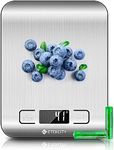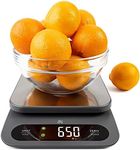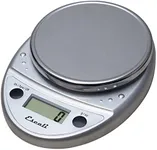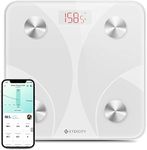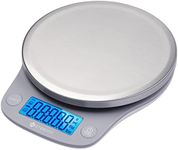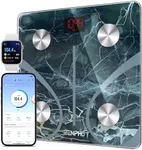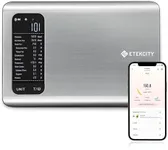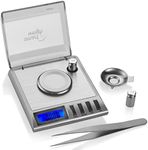Buying Guide for the Best Digital Scales
Choosing the right digital scale involves understanding your specific needs and the key features that different models offer. Digital scales can be used for various purposes, such as weighing yourself, measuring ingredients in the kitchen, or even for scientific purposes. Knowing what you need the scale for will help you narrow down the options and select the best one for you. Here are some key specifications to consider when choosing a digital scale and explanations to help you understand their importance.AccuracyAccuracy refers to how close the scale's measurement is to the actual weight. This is important because you want reliable and precise readings, especially if you are using the scale for health monitoring or cooking. Accuracy is usually measured in grams or ounces. For general use, a scale with an accuracy of 1-2 grams is sufficient. For more precise needs, such as baking or scientific measurements, look for a scale with an accuracy of 0.1 grams or better.
CapacityCapacity is the maximum weight the scale can measure. This is important because you need to ensure the scale can handle the weight of the items you plan to weigh. Digital scales come in various capacities, ranging from a few grams to several hundred pounds. For personal body weight scales, a capacity of up to 400 pounds is common. For kitchen scales, a capacity of 5-10 kilograms (11-22 pounds) is usually sufficient. Choose a scale with a capacity that exceeds your maximum expected weight to ensure durability and accuracy.
Units of MeasurementUnits of measurement refer to the different weight units the scale can display, such as grams, ounces, pounds, and kilograms. This is important because it allows you to use the scale for various purposes and follow different recipes or guidelines. Most digital scales offer multiple units of measurement, which can be easily switched with a button. Choose a scale that offers the units you are most comfortable with and that match your needs.
DisplayThe display is the part of the scale where you read the weight measurement. A clear and easy-to-read display is important for convenience and accuracy. Look for a scale with a backlit display, which makes it easier to read in low light conditions. The size of the display and the digits should be large enough to read at a glance. Some scales also offer additional information on the display, such as body fat percentage or nutritional data, which can be useful depending on your needs.
Tare FunctionThe tare function allows you to reset the scale to zero after placing a container on it. This is important for accurately measuring the weight of ingredients without including the weight of the container. This feature is especially useful in the kitchen when you need to measure multiple ingredients in the same bowl. To use the tare function, place the empty container on the scale, press the tare button to reset the display to zero, and then add the ingredients.
Platform SizeThe platform size is the surface area where you place the items to be weighed. This is important because it determines the size of the items you can weigh. For personal body weight scales, a larger platform provides better stability and comfort. For kitchen scales, a smaller platform is usually sufficient, but make sure it can accommodate the size of your bowls or plates. Choose a platform size that matches the typical size of the items you plan to weigh.
Additional FeaturesAdditional features can enhance the functionality and convenience of a digital scale. Some common additional features include Bluetooth connectivity, which allows you to sync the scale with a smartphone app for tracking your weight or nutritional data. Other features might include a built-in timer, auto-off function to save battery life, or waterproof design for easy cleaning. Consider which additional features would be beneficial for your specific needs and choose a scale that offers those.
